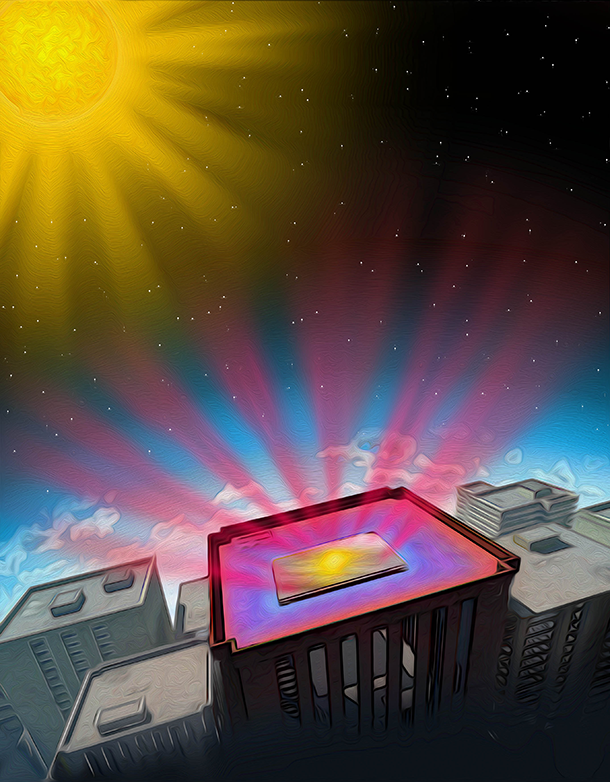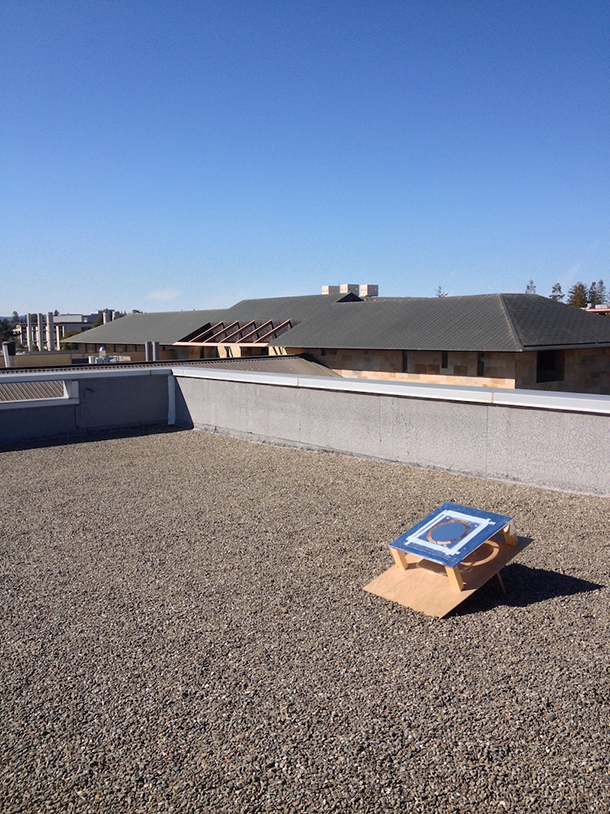Infrared Technology To Cool Buildings
Air Date: Week of November 13, 2015

An artist’s rendition of the sky cooling system in action. (Photo: Nicolle Fuller, SayoArt LLC)
The US Department of Energy estimates that air conditioning consumes nearly fifteen percent of energy used by buildings. Now, as Living on Earth’s Jake Lucas reports, a group of Stanford physicists and engineers have developed a technology to keep buildings cooler by reflecting sunlight as infrared radiation out into the coldness of space from the building’s roof.
Transcript
CURWOOD: It’s Living on Earth, I'm Steve Curwood. In a minute, a possible key to storing vast amounts of renewable energy, but first this note on emerging science from Jake Lucas.
LUCAS: The Department of Energy estimates that almost fifteen percent of the energy US buildings used in 2011 went to powering air conditioners. As the climate warms, that percentage is likely to grow.

The experimental system on a sunny roof in Stanford, California. (Photo: courtesy of Aaswath Raman)
So there’s an urgent need for less energy-intensive ways to keep buildings cool. And now, a team of Stanford physicists and engineers has developed a system that uses the infinite cold of outer space to do just that.
Their set up is designed to sit on a building’s roof and emit infrared light primarily within a specific range of wavelengths. That allows the light to pass through a sort of infrared light window in the atmosphere. The system is made of alternating layers of hafnium dioxide and silicon dioxide, some thicker, some thinner. Differences in how light passes through those two materials and their varying thicknesses allow this invention to emit infrared light without absorbing very much of it, which would heat up the system.

Aaswath Raman, lead author of the group’s paper. (Photo: courtesy of Aaswath Raman)
The Stanford scientists are not the first group to do this, but what makes their set up unique is that it’s pretty cheap to make, and it reflects sunlight, so it works during the day. In fact, in direct sun, their system was able to cool the air by nearly 5 degrees Celsius, about 9 degrees Fahrenheit. And, they say there’s still room for improvement.
One lingering question is how to get a building’s heat through floors and insulated ceilings to the system on the roof, but the group from Stanford is working on that too. And once they figure it out, they say their set up could lend a much-needed hand to all those air conditioners. And that is pretty cool.
That’s this week’s Note on Emerging Science. For Living on Earth, I’m Jake Lucas.
Links
The group’s paper, published in Nature
About Aaswath Raman, the paper’s lead author, and his research on sky cooling
The Ginzton Lab at Stanford, the group behind the research
The DOE’s data book on buildings’ energy use in 2011
Research review on other low-energy, or “passive”, cooling techniques like the Stanford group’s
Living on Earth wants to hear from you!
Living on Earth
62 Calef Highway, Suite 212
Lee, NH 03861
Telephone: 617-287-4121
E-mail: comments@loe.org
Newsletter [Click here]
Donate to Living on Earth!
Living on Earth is an independent media program and relies entirely on contributions from listeners and institutions supporting public service. Please donate now to preserve an independent environmental voice.
NewsletterLiving on Earth offers a weekly delivery of the show's rundown to your mailbox. Sign up for our newsletter today!
 Sailors For The Sea: Be the change you want to sea.
Sailors For The Sea: Be the change you want to sea.
 The Grantham Foundation for the Protection of the Environment: Committed to protecting and improving the health of the global environment.
The Grantham Foundation for the Protection of the Environment: Committed to protecting and improving the health of the global environment.
 Contribute to Living on Earth and receive, as our gift to you, an archival print of one of Mark Seth Lender's extraordinary wildlife photographs. Follow the link to see Mark's current collection of photographs.
Contribute to Living on Earth and receive, as our gift to you, an archival print of one of Mark Seth Lender's extraordinary wildlife photographs. Follow the link to see Mark's current collection of photographs.
 Buy a signed copy of Mark Seth Lender's book Smeagull the Seagull & support Living on Earth
Buy a signed copy of Mark Seth Lender's book Smeagull the Seagull & support Living on Earth

